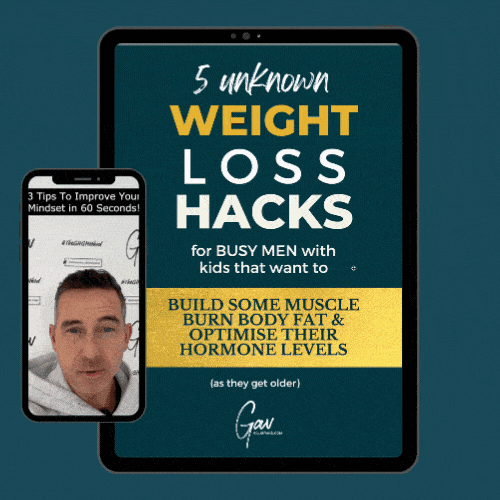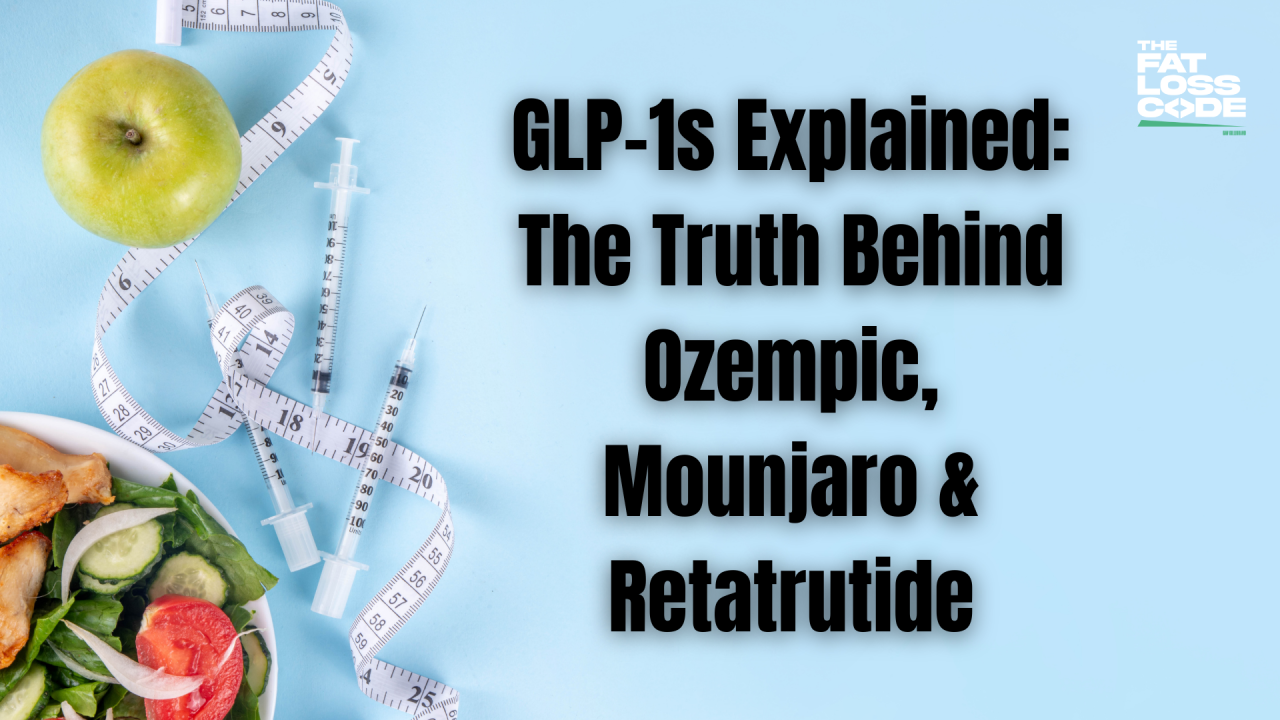If you’ve scrolled LinkedIn, TikTok, or the news recently, you’ve seen the buzz: Ozempic. Mounjaro. Retatrutide. They’ve been called miracle drugs, dangerous shortcuts, and everything in between.
With hype comes confusion. Are GLP-1s a genuine breakthrough? Or just another fad?
In this article, I will look at several areas: What they are, how they work, the pros, the cons, and my perspective as a coach who deals with the reality of weight loss every single day.
GLP-1s — Not New, Just Newly Famous
First, let’s clear this up: GLP-1s are not brand-new. They’ve been used for decades in the treatment of Type 2 Diabetes. GLP-1 stands for Glucagon-Like Peptide-1, which is a hormone your body already makes. Its main roles are:
- Regulating blood sugar
- Slowing how fast food leaves the stomach
- Signaling the brain that you’re full
GLP-1 medications mimic this natural hormone. The result? People feel less hungry, get full faster, and experience what many describe as the first quiet they’ve ever had around food. That quiet is life-changing for someone who’s been locked in a daily battle with cravings, hunger, and overeating.
The Big Names
- Ozempic (semaglutide): Originally approved for diabetes, now widely prescribed for weight loss.
- Mounjaro (tirzepatide): A dual-action drug (GLP-1 + GIP) that’s proving even more effective for weight loss.
- Retatrutide (still in trials): A next-generation drug hitting three pathways. Early results suggest dramatic weight loss numbers.
Beyond GLP-1: GIP and the “Triple G”
Mounjaro took things a step further by combining GLP-1 with GIP (glucose-dependent insulinotropic polypeptide). Like GLP-1, GIP is another hormone involved in blood sugar regulation and appetite. Together, they create a stronger effect, better blood sugar control, greater appetite suppression, and in trials, more weight loss than GLP-1 alone. Retatrutide pushes the boundary again. It targets three receptors: GLP-1, GIP, and glucagon. That’s why you’ll sometimes hear it nicknamed “Triple G.”
- GLP-1: lowers appetite, slows stomach emptying.
- GIP: supports insulin secretion and further appetite control.
- Glucagon receptor: helps increase energy expenditure, so the body burns more calories at rest.
In plain English: Retatrutide isn’t just about eating less, it’s also about burning more. Early data suggests this combination could produce even greater weight loss, which is why people are calling it the next evolution of this drug class.
The Pros
- Effective: Clinical trials consistently show 15–20% reductions in body weight.
- Appetite control: For many, the first time in their lives they feel normal hunger cues instead of relentless cravings.
- Improved health markers: Blood sugar control, reduced diabetes risk, and often improvements in blood pressure and cholesterol.
- Levels the playing field: People who feel like they’ve been “fighting their biology” finally get a fair fight.
The Cons
- Side effects: Nausea, constipation, diarrhea, sometimes vomiting. For most people it eases, but not for everyone. Rare but serious risks include pancreatitis and gallbladder issues.
- Cost: These drugs are expensive and not always covered by insurance.
- Dependency: Stop the injections, and weight usually returns. Not because the person “failed,” but because biology takes back control once the drug is gone.
- Misuse: Being used by people who want to drop 20–30 vanity pounds, not by those in genuine medical need.
The Misinformation Around Muscle Wasting
One of the loudest fears about GLP-1s is that they “cause muscle wasting.” Let’s set the record straight. When people lose weight on any plan, some of that weight will come from muscle as well as fat. That’s not unique to GLP-1s. It’s a basic fact of energy restriction.
What makes the difference?
- Protein intake: Eating adequate protein preserves lean mass.
- Resistance training: Lifting weights or doing strength work signals the body to hold on to muscle tissue.
There is nothing in a GLP-1 that inherently “eats away your muscle.” It’s an appetite suppressant. And yes, if appetite drops and people under-eat protein while skipping strength training, they’ll lose more muscle. But that’s not the drug’s fault, it’s the lifestyle around it. The real danger isn’t GLP-1s directly causing muscle loss. It’s people using them without guidance on nutrition and training. With the right support, muscle can be preserved and in some cases, built while on these medications.
And here’s the irony: most, if not all, pro bodybuilders are already using GLP-1s. Why? Because they allow extreme dieting without the mental torture of hunger. Of course, when you’re running 3 grams of gear, you’re not exactly worried about muscle loss as the anabolics take care of that. But it proves the point: GLP-1s themselves don’t destroy muscle. Poor diet and poor training do.
What About Sport?
Here’s something few are talking about: GLP-1s are not banned by WADA (World Anti-Doping Agency).
Personally, I think that’s nuts. Think about it: if a drug helps an athlete drop significant weight by suppressing appetite, that’s a direct performance enhancer in many sports. Lighter athletes can move faster, recover better, and carry less strain on their joints. We already know weight changes affect performance. It’s measurable. Fighters cut weight to gain an advantage in combat sports. Cyclists obsess over watts per kilo. Runners trim down to shave seconds off times, and now we’ve got a class of drugs that can dramatically reduce body weight, with no WADA ban? That’s a loophole hiding in plain sight. I’m not saying athletes shouldn’t have access to medical treatment when they truly need it. But pretending GLP-1s don’t influence performance is ignoring reality.
“But Isn’t It Cheating?”
This is one of the loudest criticisms. People say using GLP-1s is a shortcut, that it robs you of discipline, character, and the “growth” that comes from doing it the hard way. But here’s the problem with that argument: we don’t call it cheating when diabetics use insulin. We don’t call it cheating when someone with high blood pressure takes medication.
Why is obesity treated differently?
If Serena Williams, one of the most disciplined athletes in history can admit she struggled with food, maybe it’s time to accept that willpower alone is not always enough. Discipline on the court doesn’t automatically equal control around food. Those are two very different battles. GLP-1s don’t erase discipline. They don’t build habits for you. What they do is quiet the food noise so discipline can finally work.
My Perspective as a Coach
Here’s where I stand.
I wouldn’t recommend GLP-1s to someone who just wants to lose 20–30 pounds (Serena). That’s not what these drugs are for. Nutrition, structure, and coaching should always be the first line of attack. But if someone is morbidly obese, at immediate risk of heart attack, stroke, or diabetes complications? Then yes, these drugs can be life-saving. They are a last line of defence. I wouldn’t have recommended these drugs for Serena, but I don’t judge her for using them. She’s always carried more weight than her peers, often stepping onto court at 170-180lbs and still dominating. That underlying propensity to gain weight has always been there. Using a GLP-1 doesn’t make her weak. It makes her human.
The Bottom Line
Weight loss will always come down to one thing: input. Hormones, stress, sleep, metabolism, they all influence input. But the truth is the same: eat more than you burn, weight goes up. Eat less, weight goes down. GLP-1s don’t rewrite that law. They just give some people the ability to finally control input. They’re not magic. They’re not evil. They’re a tool. And like any tool, in the right hands they can change lives. In the wrong hands, they can be misused.
So the conversation shouldn’t be: “Is this cheating?”
The conversation should be: How do we use these responsibly, in the right situations, to protect health, improve lives, and yes, in sport, ensure fair play?
Because whether you like them or not, GLP-1s are here to stay. The only question is whether we’ll treat them with honesty instead of hype.
My name’s Gav Gillibrand — I help busy, high-performing men lose 20–60lbs in 3–6 months and keep it off for life. Burn fat. Build muscle. Skyrocket energy. 750+ men transformed and counting.
Here’s how I can help you right now:
1️⃣ Grab my free cheat sheet — The Top 5 Weight Loss Hacks for Men Who Want to Build Muscle, Lose Fat & Optimise Hormones as They Get Older: 👉 gavgillibrand.com
2️⃣ Book a free 15-min Body Transformation Strategy Call — pure value, no strings, just answers about your health & fitness: 👉 Book here
3️⃣ See 100s of real client transformations & testimonials: 👉 Read them here







